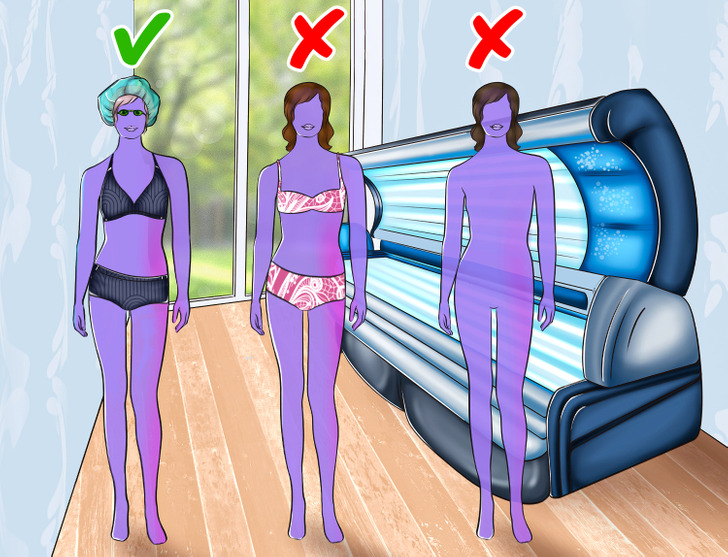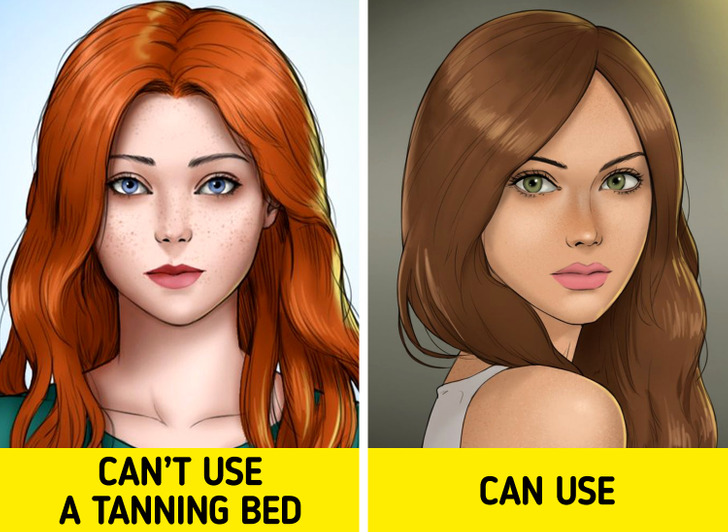How to Use a Tanning Bed Properly
Indoor tanning is quite popular and many people tend to use tanning beds quite regularly, especially in spring. However, some people don’t take recommendations from experts into account.
5-Minute Crafts would like to tell you about what things you should take into account before using a tanning bed and who should avoid this type of tanning.
❗ This article is for information only and can’t replace a doctor’s recommendations.
❗ To make sure indoor tanning is safe for you, consult a professional before visiting a tanning salon. They can help you determine your skin type and the time you can spend inside a tanning bed.
What a tanning bed is and how it works
A tanning bed is a light chamber used for indoor cosmetic tanning. A light chamber is an enclosed area with high-intensity lights in which a person can stand or lie down for a certain amount of time.
The device generates radiation almost identical to the sun’s radiation. Under its influence, the skin begins to actively synthesize melanocytes and acquire a bronze tint.
How indoor tanning affects the skin
The cells of the epidermis (the upper layer of the skin) are capable of producing the pigment melanin, which is responsible for the natural skin color. When the skin is exposed to UV radiation, it begins to produce more melanin and darkens, resulting in a tan.
❗ According to experts, there is no safe tan. A tan is a sign of skin damage and your skin tries to protect itself from ultraviolet radiation. The UV radiation in a tanning bed is 6 times stronger than the radiation of the midday summer sun, so you need to sunbathe in it with great caution. It’s worth remembering that strong or prolonged exposure to ultraviolet radiation can cause skin damage in the form of sunburns, irritation, redness, and swelling. It can also cause eye damage. Additionally, some studies show that tanning beds increase the risk of developing skin cancer.
How to use a tanning bed

- Remove your makeup before using a tanning bed to avoid accidental pigmentation and uneven tanning. Don’t wear perfume, as this may irritate the skin.
- Remove all jewelry. If you wear contact lenses, it’s also a good idea to remove them before entering the chamber.
- Avoid using sunscreen designed for sun tanning to have a smooth tan. Use products designed specifically for tanning salons.
- To protect your hair, put on a special cap before entering a light chamber. And so your lips don’t dry out, use a lip balm with a UV filter.
- Also, be sure to wear special glasses. Ultraviolet light can easily penetrate through closed eyelids and injure the retina.
- You can sunbathe in your underwear, swimsuit, or without any clothing at all. However, if you choose the latter option, be sure to use special stickers known as stikinis.
- It’s recommended to take a shower, apply a moisturizer to the body, and relax after using a tanning bed.
- People with sensitive skin are not recommended to spend more than 3 minutes in a tanning bed during the first session. For people with slightly dark skin, dark blond or brown hair, or gray or light brown eyes, the duration of the session can be increased to 10 minutes, and people with dark skin can sunbathe in the light chamber for even longer — up to 20 minutes.
- The frequency of using a tanning bed should be determined by the reaction of your skin to the “artificial sun.” For some people, it’s enough to use a tanning bed for a few minutes once a week, and others need to increase the interval up to 2 times a month. In any case, you shouldn’t use a tanning bed more often than once a day, and in case of a skin burn, you need to wait for a full recovery, and only then should you resume the procedure.
Who should avoid using tanning beds

In some cases, experts recommend either always or temporarily avoiding using a tanning bed. This is who should avoid using tanning beds:
- People with fair skin who are prone to freckling and with skin that burns easily in the sun
- Children since their skin has lower levels of melanin
- Women during their period since indoor tanning can increase discharge and exacerbate pain
- People who are taking certain medications (antibiotics, diuretics, hormonal therapy, etc.)
- Pregnant and lactating women
- People with a lot of moles and rashes on the body
- People with certain diseases (like problems with the liver, kidneys, and thyroid gland)
- After epilation and peeling
- Immediately after taking a shower or visiting a sauna